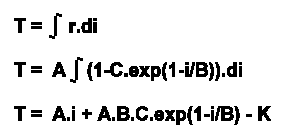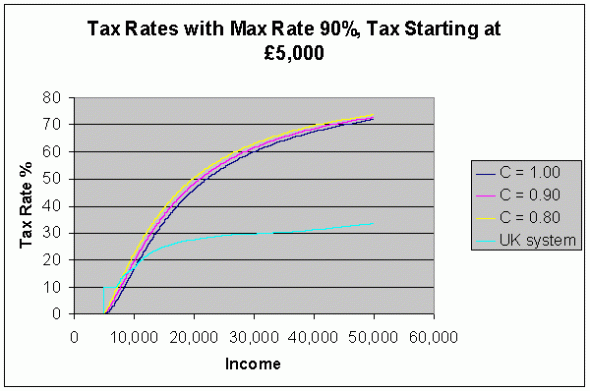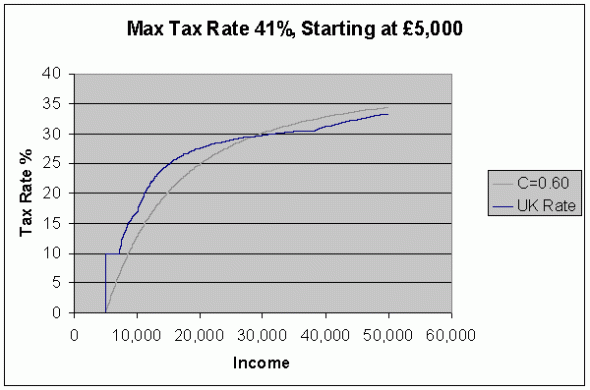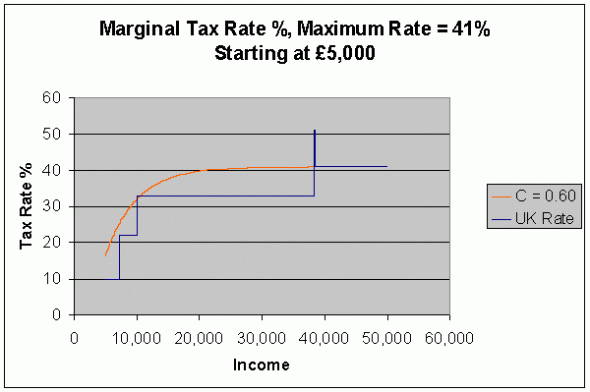The traditional economic system progresses in a series of repeating cycles. In times of major unemployment, any increase in income for the majority of people results in an increase in demand for consumer goods. The sale of these gives income to others which again is spent on consumer goods and services. This cyclic effect results in more people being employed, boosting the effect still further.
Once a certain level of demand is reached there is a need to increase productive capacity, not only by increased employment of labour but also by purchase of production equipment, boosting the cycle still further. This process of increasing production, sales, consumption and investment continues until unemployment reaches a low level, at which point the increase must stop. The stop comes because of physical limits, However, because there are delays in the system, demand for goods and services continues to increase, leading to increase in prices (normal supply and demand effect), so a period of inflation ensues.
Since there is no labour available to increase production further, the demand for capital goods begins to fall off, so the whole cycle goes into reverse. This is how capitalist economies have been operating for many decades or even centuries, with governments attempting to intervene with varying degrees of understanding and success.
When a truly sustainable economy is practised, with a stable population level and working to provide sufficient of everything rather than trying to maximise production and consumption, this process cannot function, so what will happen instead?
With population and consumption held at a steady level, there will be little demand for new equipment and even less for the machinery that makes the capital equipment itself – so little that both the machinery itself and the people who know how to use it will only have at best part-time employment in many cases. For example, if everyone who needs a washing machine already has one and the number needed does not change, very few will be needed to replace those completely worn out or damaged, so there is a real danger that the skills needed to make a washing machine may be lost. The equipment and skills needed to make a washing machine are no doubt also used to make other things, but the same problem is likely to apply to them all. I don’t know what the process is for making a modern washing machine, but I have no doubt that they are now mass-produced by automated machinery. In a sustainable economy washing machines, like most things, will be built to last and to be easily repairable, unlike those made today, so far fewer will be needed as replacements
The main problem, however, is that the economic system is inherently unstable, with positive feedback amplifying any perturbation. A means of stabilising it is needed which provides employment for all who want it and a stable currency. No one has yet devised a system for achieving this without abandoning capitalism entirely, and with it the freedom of choice that a satisfactory life demands. There is no doubt that an economy based on sufficiency, instead of greed for ever more wealth, is one essential component of such a solution, but this requires a major shift in society’s values to achieve. In the meantime, and on the way to achieving it, we need to find another means of stabilising the system. Since the problem is not one of negative feedback with lags but the relatively simple one of straightforward positive feedback, the obvious answer is to institute some form of negative feedback. This is what the Keynesian system of stimulating growth in times of high unemployment was designed to do. Unfortunately, at least as it has been applied in the past, it has been excessive, and usually also late, and so has produced not stability but a reversal of the cycle. Something much more finely tuned and promptly applied is needed, and it needs to be applicable in both directions as needed, not just one.
The Keynesian system at least gives us a clue as to what to look for in such a system. The level of unemployment, properly and accurately measured, is what must be measured (or at least one of the things – there may well be others also having an influence), and government expenditure is a major controlling variable, but of course, as always, life is not that simple. One problem is that the effect of government expenditure in this respect depends on what kind of expenditure it is. Money spent on, for example the so-called “quantitative easing” used in the period 2008-2013, which amounted to feeding money to banks in the hope they would in turn lend it to industry to fund expansion, predictably failed, partly because banks chose not to use it in that way and partly because it did nothing to stimulate demand, which alone would encourage industry to want to invest. To be effective, the government expenditure must directly put money into the hands of people who will spend it on goods and services. This can be quite effectively done by spending or reducing spend on infrastructure projects (in accounting terms, capital expenditure) such as transport facilities and energy production, as advocated by Keynes, or it could be done by simply increasing or decreasing welfare benefits (or other revenue expenditure) or by reducing or increasing taxation (not strictly speaking expenditure of course, but its equivalent so far as its effect on this system is concerned). These all have their advantages and disadvantages, both from the point of view of effectiveness and in terms of their other effects on people’s lives and on the overall objective of sustainability.
Before considering those three options, we must also look at other problems with attempting to control the system in this way. When people receive additional income, then do not necessarily spend it all on goods and services, but instead put some of it into savings. Only that part which they spend is effective in stimulating the economy. Economists talk of the “propensity to save”, being the proportion of their additional income that people put into savings instead of spending immediately. It is an established fact of life, and intuitively fairly obvious, that the greater a person’s income the higher their propensity to save is likely to be. At the extreme, a small increase in income to a multi-millionaire would not have any effect whatever on his spending and his propensity to save will be 1 (the maximum – he saves it all because he has nothing extra to spend it on), while the same increase to a person struggling to feed and clothe a family will all be spent immediately on the essentials of living – his propensity to save is zero.
A further problem which is difficult to solve is that when the money is spent on consumer goods and services it may go on things which do little to stimulate employment, such as gambling, or on imported goods. The latter will stimulate the economy of the exporting country, but not that of the country spending the money. The first problem could theoretically be solved by criminalising much of the undesirable activities, but this is hardly compatible with a culture of freedom. The second could be solved, as it was from the time when the gold standard was abandoned in favour of “fixed” exchange rates until the advent of freely floating currencies and the removal of restrictions on the export of money some decades later. This is not the place to discuss the advantages and disadvantages of fixed exchange rates but clearly restrictions on the export of money is again not compatible with freedom.
Now let us look in turn at the main forms of government income and expenditure and consider the implications of each, both in terms of effectiveness and of the wider considerations.
1. Infrastructure projects
Infrastructure projects, if managed properly from this point of view, have been shown many times to be reasonably effective. Not all of the money spent goes to people who will spend it on goods and services, but most of it does (the remainder goes into company reserves and in repayment to banks of company loans and interest on those loans), but there are major delays with some of it when the initial contractor uses some of the funds to buy goods and services from other companies, and even more so with that part which is used to pay dividends to shareholders. Indeed, much of the dividends part goes entirely into savings when the shareholder in an insurance company, pension provider or other financial institution. Most of the money, however, goes directly to people in the form of wages, salaries and directly as payments for goods and services, although not only or even mainly to people who will spend it all.
Most of what we normally think of as infrastructure projects, such as building roads, railways, bridges, power stations, etc. are simply not required in a sustainable, steady-state economy. In a growth economy they are highly desirable and have traditionally been welcomed for this reason, but in a steady state they are only needed as occasional replacements. The equivalent in the form of maintenance of existing facilities could be used instead, although there would be an upper limit to what is needed and a lower limit below which it would be short-sighted to go. This could possibly be at least a part of the control action which should be used, but those limits may not be far apart so its usefulness is very limited.
2. Revenue expenditure
Government revenue expenditure takes many different forms and these need to be considered separately
2.1 Direct employment
Many government services are performed by people directly employed by the government. Obvious examples are the armed services, the police, teachers in state schools and health workers in state hospitals and other state health services, but there are many others, the details of which vary somewhat from country to country. The effectiveness of changing this form of expenditure as a control mechanism will depend primarily on the rates on pay of the people concerned. Increasing or reducing the numbers of people employed is not something that can be done instantly, but is likely to take a number of months. However, pay increases can be implemented very quickly, but are much more difficult, both politically and morally, to reduce other than through changes in the number of overtime working hours. It follows that as a rapid two-way mechanism this is only useful to the extent that paid overtime is relevant to the particular jobs, which is much more in some forms of work than in others. Changing the numbers employed, especially in the lower paid jobs, would also be effective if the lower speed of action is compatible with the needs of the system.
2.2 Purchase of goods and services
Governments purchase from commercial companies huge quantities of goods and services. The nature of some of these is such that the quantity purchased cannot readily be varies, but many others can be changed very easily, and in that sense are very suitable for our purpose here. However, as usual, life is not so simple. If the result is to put money into the economy, then it must go to individuals who will spend it, not into large company profits nor, as a result of imports, to foreign organisations. On the other hand, if the volume of purchases from very small companies varies too much, the companies themselves will suffer severely when purchases are reduced – this is not necessarily undesirable, since it would involve a direct change to the unemployment level, which is the object of the exercise. Great care must therefore be exercised in choosing which products and services to use for this control purpose. Broad brush budgetary variations at the level of entire government departments is definitely not the way to do it! However, subject to this, we have here a very suitable control.
2.3 Welfare payments
Welfare payments are the direct payment of cash to individuals, primarily for the relief of actual or threatened poverty, such as pensions, unemployment relief, disability relief, etc. Properly directed welfare payments, by their very nature, go to those at the bottom of the income scale who will spend more or less all that they receive, so the effect of changes to these will be immediate and total. From the point of view of the control system, they are the ideal tool. From a humanitarian viewpoint, however, they are not suitable at all. The problem is not when an increased economic stimulus, requiring an increase in payments, is needed, but when it is necessary to go in the other direction. Cutting payments to vulnerable people struggling to manage on very limited means is unacceptably cruel. This is a control which could only be acceptable to operate in one direction, which has obvious problems of its own. My conclusion is that this may be useable on occasions, but only for increases and therefore not as a regular part of the system for normal use.
3. Tax changes
Since the purpose of taxation is to balance government income and expenditure, this seems the obvious mechanism to use for the control we seek. The overall structure of the tax take must clearly be such as to achieve the steady state, the control action needs to be such that it affects primarily the tax liabilities of those with a low propensity to save but nevertheless subject to tax. This means, using the income tax formula proposed (see previous post, below), the changes should be to both the parameter C which affects mainly the lower incomes, reducing it slightly to increase the tax, and possibly also parameter A.
Changes to other types of tax, such as that on companies, are not relevant to this type of control because they do not directly change the amount of money being used to buy goods and services.
4. Borrowing
In order to balance the national budget, an alternative to raising taxes is to borrow (or repay loans as an alternative to lowering taxes). Governments borrow money by issuing bonds for sale, and repay loans by redeeming previously issued bonds. However, bonds are almost all bought by financial institutions and even those few which are bought by private citizens are purchased using savings rather than at the expense of buying consumer goods and services, so while borrowing is relevant to the government’s overall need to balance income and expenditure, it is completely irrelevant to the control mechanism being discussed here.
Implementation
A considerable amount of carefully directed research will be needed in each country before attempting to use this system in order to determine what balance of the various controls mentioned is most appropriate and what magnitude of change is required to produce what magnitude of effect, and how quickly. This research must be both practical by measuring all relevant factors but also theoretical, using advanced control system theory. Furthermore, this research will have to be ongoing once the system is in place and working, partly to monitor its effectiveness and partly so as to make any necessary modifications to take account of changed conditions, such as in international markets, social changes, new inventions, natural disasters and so on. This is not just a feedback control system, but an adaptive system, changing its control parameters to meet changing conditions. This is most certainly not an area for the exercise of political prejudice by government of whatever colour!




